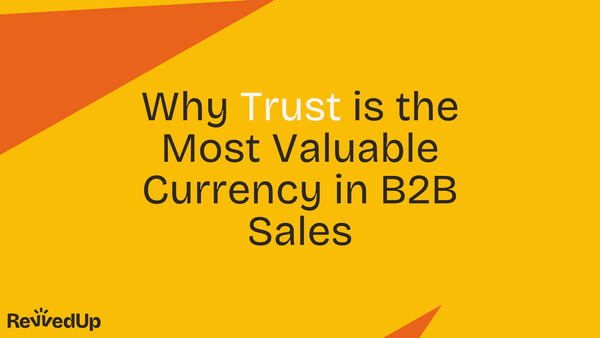Why Trust is the Hardest—and Most Valuable—Currency in B2B Sales

The Growing Buyer-Seller Divide
If you're in B2B sales or marketing, you've likely noticed that closing deals has become more challenging. Sales cycles are longer, and even promising leads can stall unexpectedly. This isn't just anecdotal; it's a trend supported by data.
According to Insight Revenue's "State of Revenue 2025" report, the gap between buyers and sellers is not only real but widening, primarily due to a significant erosion of trust.
So, what's driving this breakdown—and what can revenue leaders do to bridge the gap?
This is what we discussed in a live webinar with Insight Revenue’s CEO; and the CRO of ChartMogul, who also presented some exclusive data of her own!
Watch the full discussion or jump to the key take-aways below
The Data: What's Really Happening in the Revenue Trenches
Let's delve into the findings from the report:
- Buyers are overwhelmed. The report indicates that buyers are inundated with choices and information, leading to decision paralysis.
- Sellers are misaligned. While buyers seek simplicity and predictability, sellers often push for comprehensive, strategic partnerships that may not align with the buyer's current needs or risk appetite.
- Deals are stalling. The research highlights that more deals are stalling at mid-to-late stages, particularly during negotiation, onboarding, and implementation phases.
A critical insight from the report is that both buyers and sellers lack confidence in the value propositions being presented. Buyers often perceive ROI claims as overly optimistic, while sellers themselves may not fully believe in the business cases they present. This mutual skepticism contributes to stalled deals and prolonged sales cycles.
The Trust Gap: Why No One Believes Your ROI Slide
The report underscores a fundamental lack of trust—not just in vendors, but in the sales process itself.
- Buyers are wary of broken promises. Past experiences with underperforming products have made buyers skeptical of vendor claims.
- Sellers rely on outdated playbooks. Many sales teams continue to use traditional qualification frameworks and volume-based outreach, which fail to address the specific contexts and needs of modern buyers.
- Stakeholder misalignment. The report reveals that sellers often engage with only a subset of the actual decision-makers, missing out on key stakeholders who influence the buying decision.
Moreover, the report highlights that the one thing buyers value most—unique insights about their business—is consistently the area where sellers underperform. Without a deep understanding of the buyer's challenges, sellers struggle to build trust and differentiate their offerings.
What High Performers Get Right: From Process to Partnership
The report identifies four key practices of top-performing sales teams:
- Deep customer understanding. High performers invest time in comprehensively understanding the buyer's priorities, strategies, and risk factors.
- Collaborative value creation. Rather than dictating value, these teams co-create business cases with buyers, ensuring alignment and credibility.
- Comprehensive stakeholder engagement. They identify and engage all relevant stakeholders, not just the primary contact, to ensure collective buy-in.
- Proactive implementation planning. Top teams help buyers visualize adoption and success metrics from the outset, facilitating smoother onboarding and value realization.
Outcome vs. Input: What Are You Actually Selling?
The report challenges the conventional wisdom of selling outcomes by emphasizing the importance of inputs—the specific actions and processes that lead to desired results.
- Inputs build credibility. Buyers are more likely to trust and engage with vendors who clearly articulate the steps and resources involved in achieving outcomes.
- Shared language fosters trust. When buyers can articulate, in their own words, how a solution addresses their challenges, it signifies a deeper understanding and trust in the vendor.
Brand Is Back (But Not in the Way You Think)
A notable finding from the report is the resurgence of brand importance.
One of the strongest patterns among top performers is investment in brand. Not just logos and taglines, but an authentic presence and a reputation for credibility. In a world of risk aversion and low trust, buyers need to feel that you’re safe, stable, and invested for the long haul.
This isn’t about vanity—it's about reducing perceived risk. In categories where the “best” vendor is hard to distinguish, the one with the strongest brand almost always wins.
AI: The Great Leveler—or Just More Noise?
The report discusses the dual role of AI in sales:
- Efficiency vs. effectiveness. While AI can increase outreach volume, without personalized and context-rich messaging, it may contribute to market noise rather than meaningful engagement.
- Augmentation, not replacement. The optimal use of AI is to augment human capabilities—enhancing research, insight generation, and personalization—while preserving the human elements of relationship-building and trust.
The Playbook for 2025: How to Close the Gap
Based on the report's findings, here are actionable steps for sales teams:
- Prioritize customer understanding. Invest in research and discovery to truly grasp the buyer's context and needs.
- Collaborate on value creation. Engage buyers in building the business case and implementation plan, ensuring alignment and ownership.insightrevenue.com
- Engage all stakeholders. Identify and involve all decision-makers to facilitate consensus and reduce friction.
- Build trust through credibility. Focus on establishing trust early in the sales process, leveraging brand strength and consistent value delivery.
- Leverage AI strategically. Use AI tools to enhance, not replace, human interactions—supporting research and personalization efforts.
Closing Thoughts: Trust Is the New Growth Lever
The "State of Revenue 2025" report makes it clear: the future of B2B sales hinges on trust.
In an era where buyers are cautious and skeptical, sales teams must prioritize building genuine, trust-based relationships.
By deeply understanding customer needs, collaborating on value creation, and leveraging both human insight and technology, organizations can bridge the buyer-seller gap and drive sustainable growth.
For a deeper dive into the state of the market, closing the trust gap and leveraging AI to build a stronger brand, find a time to speak to the RevvedUp team!




